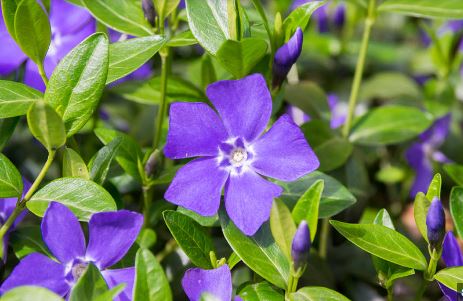
General Information
- Common Name: Periwinkle or Lesser Periwinkle
- Scientific Name: Vinca minor
- Family: Apocynaceae
Vinca minor is a species of flowering plant in the dogbane family, native to central and southern Europe, from Portugal and France north to the Netherlands and the Baltic States, east to the Caucasus, and also southwestern Asia in Turkey. Other common names for this plant include small periwinkle, common periwinkle, and sometimes in the United States creeping myrtle.
This is a trailing, vine-like plant that spreads along the ground. It grows relatively low to the ground, often not more than 6 inches tall but can spread indefinitely if not contained. The plant develops roots at the nodes where the leaves meet the stem, allowing it to spread and become quite invasive in favorable conditions.
Leaves are evergreen, Opposite, glossy, and oval to lanceolate in shape, about 1-2 inches long. The leaves are dark green, but there can be variegated forms with edges or blotches in white or yellow. Flowers are generally blue, although there are varieties with white, purple, or even reddish flowers. The flowers have five petals that are fused at the base forming a tubular shape, then spreading out into a flat, star-like pattern. Bloom time is primarily in early spring, but can have sporadic blooms in summer or even autumn in milder climates.
When growing in cultivation, Periwinkle works well with other shade-loving plants like ferns, hostas, or under larger shrubs and trees where grass struggles to grow.
In some regions, particularly in North America, Vinca minor is considered invasive. Its ability to spread and form dense mats can lead to the suppression of native flora. This characteristic, while useful for ground cover in controlled settings, makes it problematic in natural environments. When used in gardens, care should be taken to contain periwinkle to prevent it from spreading into areas where it’s not wanted.
Periwinkle has been used in traditional European herbal medicine for centuries, mainly for its supposed effects on memory and circulation. It contains alkaloids like vincamine, which has been used in some pharmaceuticals aimed at enhancing memory or treating circulatory disorders. However, these uses are not widespread in modern medicine due to potential toxicity and the availability of more effective treatments.
Ecological and Practical Uses
- Used in gardens for its evergreen leaves and pretty flowers. It’s often found in woodland gardens or as an underplanting for shrubs and trees.
- Historically, Vinca minor has been used in traditional medicine, though it contains alkaloids like vincamine, which can be toxic if ingested in large quantities.
- Excellent for covering large areas, preventing erosion, and suppressing weeds due to its dense growth.
- Used in landscaping for borders, underplanting in shrubberies, or in woodland gardens. Its evergreen leaves provide year-round interest, and its flowers add a splash of color.
Cultivation and Care
Site Selection:
- Light: Prefers partial to full shade. It can tolerate some sun, especially in cooler climates, but too much direct sunlight might scorch the leaves.
- Soil: Well-drained soil is ideal, but Vinca minor can adapt to various soil types, including clay or sandy soils. It prefers slightly acidic to neutral pH but is not overly fussy.
Planting:
- Timing: Plant in early spring or fall to allow the roots to establish before extreme weather conditions set in.
- Spacing: Space plants about 12 to 18 inches apart if you want them to fill in quickly. They will spread and cover the ground over time.
Watering:
- Initially, water regularly to help the plant establish itself. Once established, periwinkle is relatively drought-tolerant but will do better with occasional watering during dry spells.
Pests and Diseases
- Generally, periwinkle is not heavily pestered by insects, but slugs and snails might occasionally be a problem.
- It can suffer from gray mold (botrytis) in humid conditions or from rust. Good air circulation and avoiding overhead watering can help prevent these issues.
Controlling Spread
- Use barriers or plant it in areas where its spread can be naturally contained by pathways, walls, or other physical barriers.
- Regularly check for and remove any shoots that are spreading beyond the desired area.
Propagation
- Division: The easiest method. Dig up a clump, divide it into smaller sections, and replant. This can be done almost any time of the year but is best in spring or fall.
- Cuttings: Take stem cuttings in late spring or early summer, remove lower leaves, and plant in a mix of sand and peat or directly into the ground where you want them to grow. Keep moist until roots develop.
- Layering: Since periwinkle roots at the nodes, you can encourage rooting by pinning down stems to the soil, where they will develop roots.